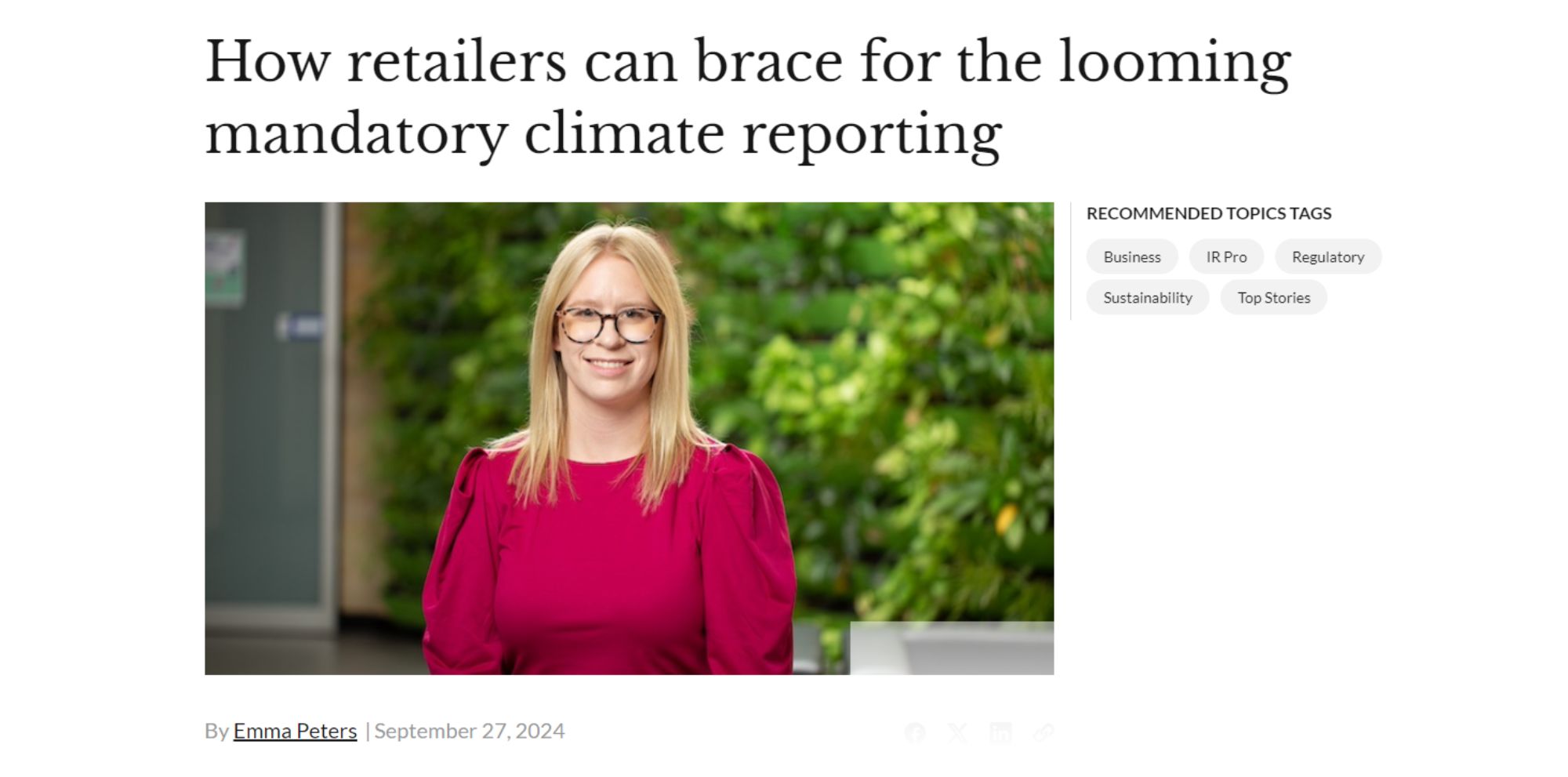 As originally published in Inside Retail Pro
As originally published in Inside Retail Pro
Over the next few years all retailers with a turnover of over $50 million will be expected to publish a ‘sustainability report’ and include a range of data about their carbon emissions and climate mitigation efforts.
This comes after the Federal Parliament passed a bill last week to introduce mandatory climate reporting in Australia, setting the agenda for one of the most significant new regulatory imposts across businesses in decades – and posing a particular challenge for retailers and their suppliers.
The bill introduces amendments to the Corporations Act 2001, legislating mandatory climate-related financial reporting requirements. Many retailers are unaware that these reporting requirements are coming and are unprepared for the significant changes this will bring.
Businesses that do not prepare will be left behind, as large retailers are expected to start collecting data from January 1 2025 and seek climate data from their suppliers.
This could become a differentiator for who big businesses choose to do business with.
Here are 10 tips for retailers to get ready for mandatory climate reporting.
1. Assess your overall climate literacy
Climate change is now a “business-as-usual” consideration. For most businesses, this is new territory. It is important for organisations to establish climate change as a key corporate governance and strategic business risk and opportunity going forward.
2. Identify associated business opportunities
A key business opportunity for reporting entities will likely be to prioritise engaging with suppliers that can provide the data needed to fulfil their reporting obligations. Over time it’s also possible that those with a better emissions performance could become more attractive business partners.
3. Identify potential reporting entities in your customer base
Undertake an assessment of your customer base and understand which customers you will likely have to provide climate data to. While there is a one-year phase-in period for when these organisations have to report on their supply chain greenhouse gas emissions, reporting entities will be starting to collate this data early due to the significant time and effort required to obtain this data.
4. Undertake a data and reporting gap analysis
For suppliers, the key data point that reporting entities will be seeking is the “product or service-level cradle-to-gate” greenhouse gas emissions. This includes the greenhouse gas emissions associated with the goods and services based on the materials, fuel and electricity used, as well as the distance transported and waste generated, from the production of goods and services.
Collecting this data can take 12-18 months depending on the availability of data within your organisation. Accordingly, it is imperative to start to collect this data now and work towards filling gaps identified.
5. Create a roadmap and action plan to fill gaps
Based on the gap analysis, create a roadmap and action plan outlining actions that need to be undertaken to be able to comply with the disclosure and data requirements.
6. Engage representatives from key teams in your organisation
Climate reporting requires data and input from multiple teams, including procurement, finance and management. It is important to bring the business on the journey with these new reporting requirements to ensure that the “why” is effectively communicated and understood internally.
7. Measure greenhouse gas emissions against the right benchmark
When starting the process of measuring greenhouse gas emissions, aligning against a framework is critical to have accurate greenhouse gas emissions calculations. The GHG Protocol is the global baseline for carbon accounting and should be used as the basis of greenhouse gas emissions calculations and categorisation.
8. Assess your organisation’s climate risks and opportunities
Reporting entities will need to assess and report on, climate-related financial risks and opportunities, including those relating to their value chains. Assessing these risks and opportunities will put you in good stead when these conversations have to take place with your customers.
9. Keep records of calculations and any assumptions used in preparing disclosures
Assurance is required over the data used to prepare the climate reports. Keeping appropriate records and being able to show the process of calculating greenhouse gas emissions will be critical to fulfil this requirement.
10. Assess how technology can assist your organisation in ongoing reporting requirements
Data availability and quality are the biggest obstacles to having good-quality climate data. Technology and automation can help to automate the data gathering and calculation process and acts as a “source of truth” for all calculations that have taken place.
While this requirement is being phased in over several years it ramps up quickly and for many businesses, it might seem overwhelming. My advice is not to ignore it.
This publication has been prepared for general guidance on matters of interest only and does not constitute professional legal advice. You should not act upon the information contained in this publication without obtaining specific professional legal advice. No representation or warranty (express or implied) is given as to the accuracy or completeness of the information contained in this publication and to the extent permitted by law, Cowell Clarke does not accept or assume any liability, responsibility or duty of care for any consequences of you or anyone else acting or refraining to act in relation on the information contained in this publication or for any decision based on it.
